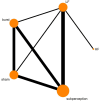Comparative Effectiveness of Different Frequencies of Spinal Cord Stimulation for the Treatment of Patients with Failed Back Surgery Syndrome: Systematic Review and Network Meta-Analysis
- PMID: 40822431
- PMCID: PMC12350554
- DOI: 10.2147/JPR.S513725
Comparative Effectiveness of Different Frequencies of Spinal Cord Stimulation for the Treatment of Patients with Failed Back Surgery Syndrome: Systematic Review and Network Meta-Analysis
Abstract
Purpose: Failed back surgery syndrome (FBSS) is a common and challenging complication after lumbar spine surgery, with around 30% of patients experiencing this condition post-surgery. Spinal cord stimulation (SCS) is a prevalent treatment for FBSS, yet there is a lack of systematic comparisons among different SCS frequencies. This first network meta-analysis (NMA) compared the effectiveness and superiority of different SCS frequencies for FBSS.
Material and methods: Adhering to PRISMA guidelines, we searched PubMed, Web of Science, Embase, and CENTRAL for RCTs. Bayesian random-effects network meta-analysis assessed outcomes including pain reduction, functional capacity, and health-related quality of life.
Results: This NMA (11 RCTs; n=2275) revealed efficacy variations among SCS modalities. Based on surface under the cumulative ranking (SUCRA) rankings, subperception SCS (500-1200 Hz) had the highest probability for global pain relief (SUCRA=64.0%) and ≥50% pain reduction (SUCRA=75.3%; P < 0.05 vs low-frequency SCS). High-frequency SCS (10 kHz) was associated with higher SUCRA values for back pain (99.7%; P < 0.05 vs comparators; consistency χ²=1.41, P = 0.703) and leg pain (93.2%; P < 0.05 vs low-frequency SCS), suggesting a potential advantage. For functional outcomes, high-frequency SCS correlated with better ODI scores (SUCRA=85.0%), while subperception SCS showed higher probability for improved EQ-5D metrics (SUCRA=80.3%). All networks satisfied transitivity assumptions without significant inconsistency (P > 0.05).
Conclusion: This NMA suggests potential differential therapeutic profiles among SCS modalities for FBSS. HF-SCS (10 kHz) showed relatively higher SUCRA values for back pain (99.7%), leg pain (93.2%), and disability improvement (ODI 85.0%). Subperception SCS (500-1200 Hz) was associated with better probability for global pain relief (64.0%), ≥50% pain reduction (75.3%), and HRQoL outcomes (EQ-5D 80.3%). These findings warrant validation in head-to-head RCTs.
Keywords: back pain; failed back surgery syndrome (FBSS); frequency; leg pain; spinal cord stimulation (SCS).
© 2025 Qin et al.
Conflict of interest statement
All authors report no conflicts of interest in this work; no financial relationships with any organizations that might have an interest in the submitted work in the previous three years; no other relationships or activities that could appear to have influenced the submitted work.
Figures




















References
-
- Van Buyten JP, Linderoth B. “The failed back surgery syndrome”: definition and therapeutic algorithms - an update. Eur J Pain Suppl. 2010;4:273–286. doi: 10.1016/j.eujps.2010.09.006 - DOI
-
- Hoelzer BC, Edgar D, Lu SP, et al. Indirect comparison of 10 kHz Spinal Cord Stimulation (SCS) versus traditional low-frequency SCS for the treatment of painful diabetic neuropathy: a systematic review of randomized controlled trials. Biomedicines. 2022;10(10):2630. doi: 10.3390/biomedicines10102630 - DOI - PMC - PubMed
Publication types
LinkOut - more resources
Full Text Sources
Research Materials
Miscellaneous

